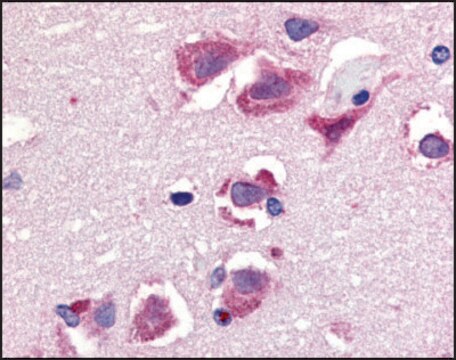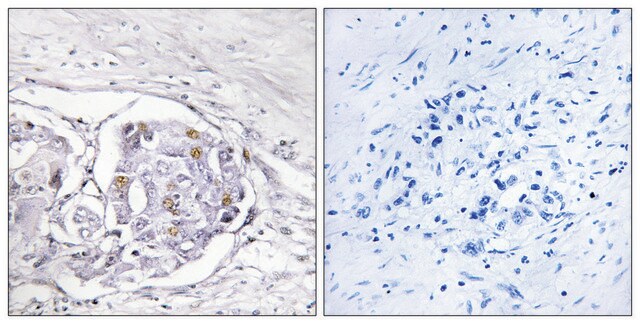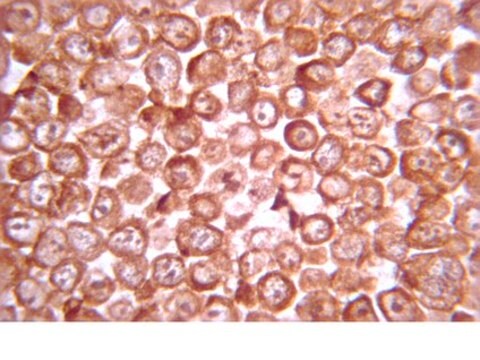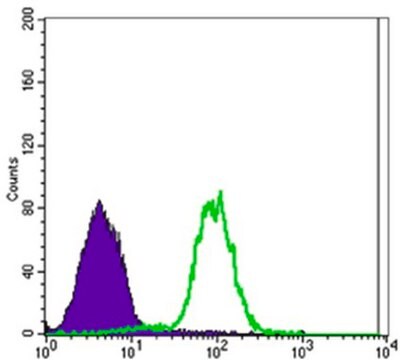MABS1234
Anti-Progesterone Receptor B Antibody, clone 250/H11
clone 250/H11, from mouse
Synonim(y):
Progesterone receptor, PR, Nuclear receptor subfamily 3 group C member 3, Progesterone Receptor B
About This Item
Polecane produkty
pochodzenie biologiczne
mouse
Poziom jakości
forma przeciwciała
purified immunoglobulin
rodzaj przeciwciała
primary antibodies
klon
250/H11, monoclonal
reaktywność gatunkowa
human
metody
immunocytochemistry: suitable
western blot: suitable
izotyp
IgG1κ
numer dostępu NCBI
numer dostępu UniProt
Warunki transportu
wet ice
docelowa modyfikacja potranslacyjna
unmodified
informacje o genach
human ... PGR(5241)
Opis ogólny
Specyficzność
Immunogen
Zastosowanie
Immunocytochemistry Analysis: A representative lot stained paraformaldehyde-fixed and Triton X-100-fixed MCF10A cells engineered to express progesterone receptor isoform B (PR-B), but not MCF10A cells engineered to express isoform A/PR-A by fluorescent immunocytochemistry (Courtesy of Dr. Dean Edwards, Baylor College of Medicine, USA).
Western Blotting Analysis: A representative lot detected endogenous progesterone receptor isoform B (PR-B) in human breast cancer T47D cell lysate, as well as exogenously expressed PR-B in transfected DCIS.COM human ductal carcinoma in situ (DCIS) breast cancer cells, but not in PR-A-transfected or untransfected DCIS.COM cells (Courtesy of Dr. Dean Edwards, Baylor College of Medicine, USA).
Signaling
Developmental Signaling
Jakość
Western Blotting Analysis: 2.0 µg/mL of this antibody detected progesterone receptor isoforms B (PR-B), but not isoform A (PR-A) in human breast cancer T47D cell lysate.
Opis wartości docelowych
Postać fizyczna
Przechowywanie i stabilność
Inne uwagi
Oświadczenie o zrzeczeniu się odpowiedzialności
Nie możesz znaleźć właściwego produktu?
Wypróbuj nasz Narzędzie selektora produktów.
Kod klasy składowania
12 - Non Combustible Liquids
Klasa zagrożenia wodnego (WGK)
WGK 1
Temperatura zapłonu (°F)
Not applicable
Temperatura zapłonu (°C)
Not applicable
Certyfikaty analizy (CoA)
Poszukaj Certyfikaty analizy (CoA), wpisując numer partii/serii produktów. Numery serii i partii można znaleźć na etykiecie produktu po słowach „seria” lub „partia”.
Masz już ten produkt?
Dokumenty związane z niedawno zakupionymi produktami zostały zamieszczone w Bibliotece dokumentów.
Nasz zespół naukowców ma doświadczenie we wszystkich obszarach badań, w tym w naukach przyrodniczych, materiałoznawstwie, syntezie chemicznej, chromatografii, analityce i wielu innych dziedzinach.
Skontaktuj się z zespołem ds. pomocy technicznej








